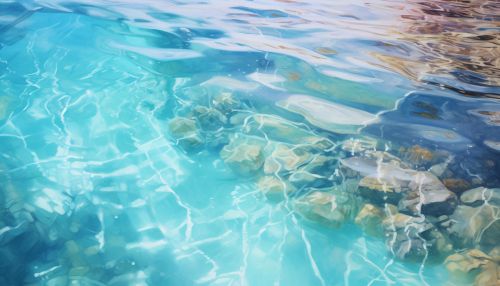Salinity
Introduction
Salinity refers to the saltiness or dissolved salt content of a body of water (see Hydrology). It is a critical factor influencing the physical and biological characteristics of the sea and estuaries. Salinity varies in different parts of the ocean, with the highest values typically found in the subtropics and the lowest values in the high latitudes and along coasts influenced by large freshwater outflows.


Measurement and Units
The salinity of water is typically measured in parts per thousand (ppt), which is the number of grams of salt in 1,000 grams of water. The average ocean salinity is about 35 ppt. However, in recent years, scientists have adopted the Practical Salinity Scale (PSS), which measures salinity using electrical conductivity. On this scale, the average ocean salinity is about 35 PSU (Practical Salinity Units).
Factors Influencing Salinity
Several factors influence the salinity of a body of water, including evaporation, precipitation, river inflow, and sea ice formation and melting.
Evaporation and Precipitation
Evaporation increases salinity by removing water and leaving the salts behind, while precipitation (rain or snow) decreases salinity by adding fresh water. Areas of high evaporation, such as the subtropics, tend to have high salinity, while areas of high precipitation, such as the tropics, tend to have lower salinity.
River Inflow
Rivers carry dissolved salts to the ocean, increasing its salinity. However, the effect is usually localized near the river's mouth and diminishes rapidly offshore. The largest rivers, such as the Amazon River and the Mississippi River, can create significant freshwater "plumes" that decrease salinity far out to sea.
Sea Ice Formation and Melting
In polar regions, the formation and melting of sea ice play a significant role in controlling salinity. When sea ice forms, it leaves most of the salt behind, increasing the salinity of the surrounding water. When it melts, it dilutes the salt water, decreasing its salinity.
Salinity and Ocean Circulation
Salinity, along with temperature, determines the density of seawater, a critical factor controlling ocean circulation. High-density water sinks, driving the deep ocean currents, while low-density water rises, driving surface currents. This process, known as Thermohaline Circulation, helps distribute heat around the globe, influencing climate and weather patterns.
Salinity and Marine Life
Salinity is a crucial factor affecting the distribution of marine life. Different species have different salinity tolerances. For example, most marine fish cannot survive in water with a salinity below 30 ppt, while some invertebrates can tolerate a wide range of salinities.
Changes in Salinity
Long-term changes in salinity can have significant impacts on the ocean and climate. Recent research suggests that global warming could lead to changes in the global water cycle, leading to increased salinity in some areas and decreased salinity in others. These changes could potentially affect ocean circulation, marine life, and coastal communities.
